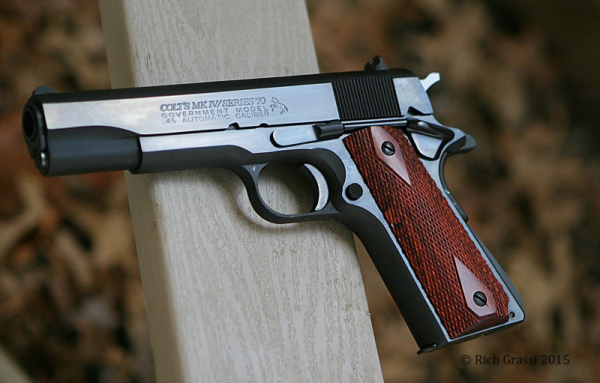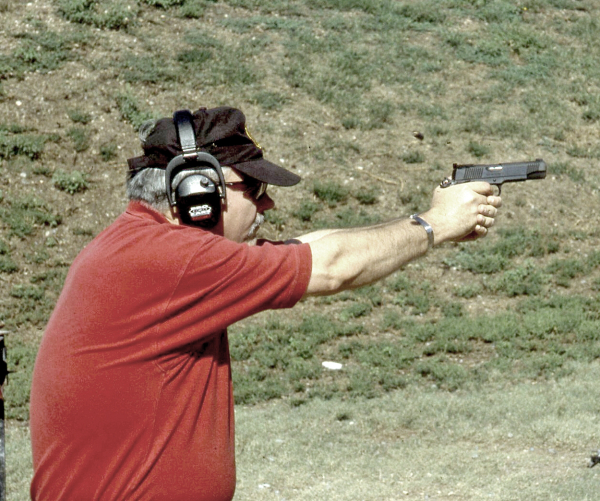My handgun journey had an inauspicious start. While I’d read everything I could about handguns as a youth, my opportunities to get handgun experience were sparse, the attempts feeble.

In my freshman year of high school, as a new student in the JROTC, I was in class when a few boxes of the US Service Pistol arrived. They lacked firing pins, but we were schooled in the technical aspects of the 1911A1 and we learned to field strip and reassemble them.
The sights were small, the guns rattled when assembled and the wear was profound.
Much later, I chatted up a couple of uncles who had police experience and their counsel was to stick with the revolver and avoid the auto pistol. Another uncle, who worked in probation and parole, carried a snub with no front sight.
Why no front sight, I asked. He said he’d explain it when I was older.
I’m still waiting.
When I joined the cops, the sergeant on my shift carried a Gold Cup in a Jordan holster. A southpaw on the shift carried a Commander hammer-down in a Jordan holster with a thumb break strap. I can’t recall anyone on days or evenings who carried any variants of the service pistol.
My own police experience with the 1911 pattern was a Colt National Match that ran properly with one magazine – the one it arrived with – and another that had been “tuned” by a pro at the range. The third was trash. Later, I traded into a “parts-bin” 1911 pistol, with an early Essex cast frame (with ‘runs’ in the surface). A Colt slide rode on top. The barrel bushing was tightly fitted, but you could get it apart without a wrench, mostly.

The sights were high fixed Micros, with the front a “hardball” post. A long solid trigger was balanced with a flat, smooth mainspring housing, “Coltwood” stocks from the 1970s, an old GI safety lever (later replaced) – and the hammer was slightly bobbed to prevent hammer bite.
Set up for GI ball, it ran surplus ammo and Federal – Monarch 230 grain ball without complaints. Remington 185 grain JHP likewise ran out of the beater 1911. It was all finished in Metaloy, a type of industrial hard chrome.
I later, stupidly, let a Kansas trooper talk me out of it with the assurance he’d sell it back if he ever moved it.
Like that “no front sight” explanation, I’m still waiting.
I’d moved on to a department that issued guns, in this case revolvers. That lasted only three years before we moved into autos, the S&W Model 645. It was remarkable in that it was stupidly reliable. We later moved into the 3rd S&W autopistol generation before I went to HK International Training Division to take their week-long Tactical Pistol, followed by Pistol Instructor the next week.
That first week I was issued the huge USP in 45 Auto. It was another attempt to try to answer issues with the original Browning pattern gun by offering solutions that weren’t required. But it was absolutely reliable, was easily maintained and was more like a service rifle in the areas of maintenance and reliability than most pistols of the era. The following week, I had the USP Compact in 40 Auto. It was the same in functional reliability, just a little smaller.
After that, I gained more exposure to the GLOCK. Pulled into that platform kicking and screaming (more or less), the reliability, ease of maintenance and repair, the vast expanse of support gear and after-market support, all led me to stay with it for the remainder of my time.
So why the look back at the flat service handgun?

Part of it is the tendency of the aged to look back with fondness at what we could sarcastically refer to as “good old days.” Another part is the feeling that I missed something along the way. I’m seeing these young squirts like Hilton Yam demonstrating they did the hard work with that Browning-inspired cannon by taking it as far as the design could go without changing the central operating system.
Then the “2011,” or double-stack 9mm variants came along. As they worked to become something close to the original in function, more externalized and handling changes were moderated by an attempt to get back to where the Utah gun designer was when he quit the design.
Now we’re seeing them in police holsters.
The “Oh, my! Your pistol is cocked!” and “There goes another jamm-a-matic” comments from those onlookers of my era have given way to little- or no notice at all. But people ignored plastic guns with pretensioned strikers too.

I’m unmoved. I look back past all that as I watch “Old Path Traveler,” “Paul W” and others on streaming media as they make their way through the M1911 morass. And as they do, I turn my gaze back to it for some periodic content about the old gun – and the old ways.
We’ll see how far I get in the time I have.
— Rich Grassi